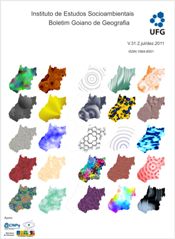RAINFALL MAPPING OF CERRADO BIOME IN THE STATE OF MATO GROSSO
DOI:
https://doi.org/10.5216/bgg.v31i2.16847Abstract
The behavior of rainfall becomes important, since it allows to detect trends or changes in climate, regional or local scales. The study mapped the distribution of rainfall in the Cerrado of Mato Grosso. We used data from 33 rainfall stations distributed in the Cerrado, with data for 30 years, from 1977 to 2006. Maps were drawn with the aid of rainfall isoline and applied to calculate the Rainfall Anomaly Index (RAI) for the classification of dry or wet periods, according to the average local, organized in a temporal average monthly, annual and seasonal precipitation. The interpolation method was used to Raster Top, which uses a multigrid simple equation to minimize the ever-improving resolutions respecting constraints of the physical elements that make up the landscape. The results of the rainfall distribution shows a wide variation in rates precipitated, and the extreme northwest and north have the largest volumes of rain and south of the lowest rainfall biome. With the analysis of the RAI for the period of study, it was found that a larger number of dry years than wet years for the period studied.Downloads
Downloads
Published
How to Cite
Issue
Section
License
Authors will not receive any payment for publishing their work in Boletim Goiano de Geografia. Therefore, they must grant all rights to the journal. However, they are entirely and exclusively responsible for the published contents, and editors are free to make corrections or adjustments to texts in conformity with publication guidelines.







